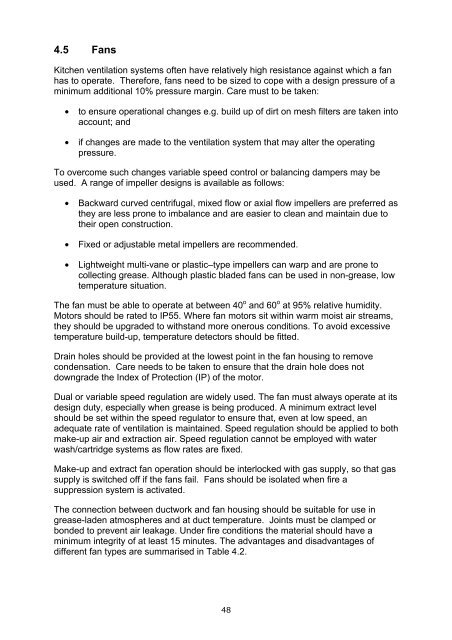Guidance on the Control of Odour and Noise from ... - Defra
Guidance on the Control of Odour and Noise from ... - Defra
Guidance on the Control of Odour and Noise from ... - Defra
Create successful ePaper yourself
Turn your PDF publications into a flip-book with our unique Google optimized e-Paper software.
4.5 Fans<br />
Kitchen ventilati<strong>on</strong> systems <strong>of</strong>ten have relatively high resistance against which a fan<br />
has to operate. Therefore, fans need to be sized to cope with a design pressure <strong>of</strong> a<br />
minimum additi<strong>on</strong>al 10% pressure margin. Care must to be taken:<br />
• to ensure operati<strong>on</strong>al changes e.g. build up <strong>of</strong> dirt <strong>on</strong> mesh filters are taken into<br />
account; <strong>and</strong><br />
• if changes are made to <strong>the</strong> ventilati<strong>on</strong> system that may alter <strong>the</strong> operating<br />
pressure.<br />
To overcome such changes variable speed c<strong>on</strong>trol or balancing dampers may be<br />
used. A range <strong>of</strong> impeller designs is available as follows:<br />
• Backward curved centrifugal, mixed flow or axial flow impellers are preferred as<br />
<strong>the</strong>y are less pr<strong>on</strong>e to imbalance <strong>and</strong> are easier to clean <strong>and</strong> maintain due to<br />
<strong>the</strong>ir open c<strong>on</strong>structi<strong>on</strong>.<br />
• Fixed or adjustable metal impellers are recommended.<br />
• Lightweight multi-vane or plastic–type impellers can warp <strong>and</strong> are pr<strong>on</strong>e to<br />
collecting grease. Although plastic bladed fans can be used in n<strong>on</strong>-grease, low<br />
temperature situati<strong>on</strong>.<br />
The fan must be able to operate at between 40 o <strong>and</strong> 60 o at 95% relative humidity.<br />
Motors should be rated to IP55. Where fan motors sit within warm moist air streams,<br />
<strong>the</strong>y should be upgraded to withst<strong>and</strong> more <strong>on</strong>erous c<strong>on</strong>diti<strong>on</strong>s. To avoid excessive<br />
temperature build-up, temperature detectors should be fitted.<br />
Drain holes should be provided at <strong>the</strong> lowest point in <strong>the</strong> fan housing to remove<br />
c<strong>on</strong>densati<strong>on</strong>. Care needs to be taken to ensure that <strong>the</strong> drain hole does not<br />
downgrade <strong>the</strong> Index <strong>of</strong> Protecti<strong>on</strong> (IP) <strong>of</strong> <strong>the</strong> motor.<br />
Dual or variable speed regulati<strong>on</strong> are widely used. The fan must always operate at its<br />
design duty, especially when grease is being produced. A minimum extract level<br />
should be set within <strong>the</strong> speed regulator to ensure that, even at low speed, an<br />
adequate rate <strong>of</strong> ventilati<strong>on</strong> is maintained. Speed regulati<strong>on</strong> should be applied to both<br />
make-up air <strong>and</strong> extracti<strong>on</strong> air. Speed regulati<strong>on</strong> cannot be employed with water<br />
wash/cartridge systems as flow rates are fixed.<br />
Make-up <strong>and</strong> extract fan operati<strong>on</strong> should be interlocked with gas supply, so that gas<br />
supply is switched <strong>of</strong>f if <strong>the</strong> fans fail. Fans should be isolated when fire a<br />
suppressi<strong>on</strong> system is activated.<br />
The c<strong>on</strong>necti<strong>on</strong> between ductwork <strong>and</strong> fan housing should be suitable for use in<br />
grease-laden atmospheres <strong>and</strong> at duct temperature. Joints must be clamped or<br />
b<strong>on</strong>ded to prevent air leakage. Under fire c<strong>on</strong>diti<strong>on</strong>s <strong>the</strong> material should have a<br />
minimum integrity <strong>of</strong> at least 15 minutes. The advantages <strong>and</strong> disadvantages <strong>of</strong><br />
different fan types are summarised in Table 4.2.<br />
48
















